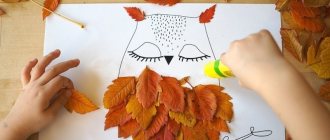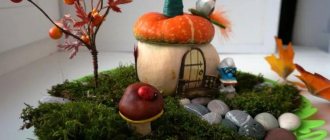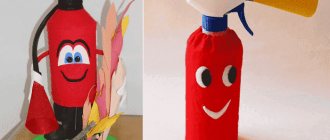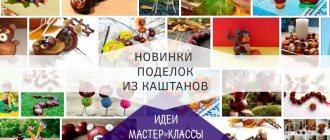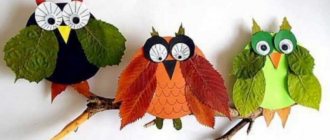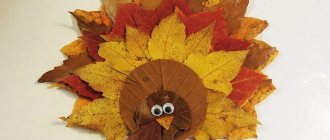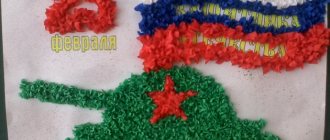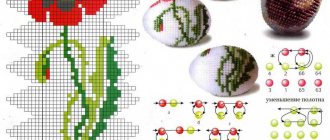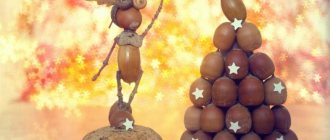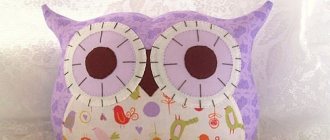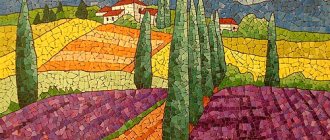Paper caterpillar
The simplest and most original way to make a caterpillar is to create it from paper rings. Such a craft will be movable, you can play with it or use it in decoration.
For work you will need materials:
- Thick paper of different colors and textures. It can be velvet, designer or corrugated paper.
- Scissors
- Glue
- Colored pencils and paints.
The rings can be used to create a giant caterpillar that can be used as a garland. These giant figures: caterpillars, butterflies, flowers and birds can be used to decorate a kindergarten hall for a holiday or a matinee.
Instructions for creating a caterpillar:
- Decide on the size of the caterpillar. Cut strips out of paper; they should be three times longer than the thickness of the insect. Half of the stripes should be the same color and texture, the other half should be another.
- Cut out a circle with antennae from paper according to the drawing - this will be the head. Also make a small strip that will become a tail. Decorate your face.
- Glue half of the strips into circles.
- Glue the face onto one ring, and the tail onto the other.
- Using other strips, assemble the caterpillar into a chain or ribbon. Glue each strip into a ring that will connect the other two.
How to make a seal from plasticine
Step 1. Create a gray mass from black and white plasticine and roll it into a ball.
We cut it into three parts. From a large piece we create an oblong body of a seal. Shape the second piece into a ball. We will leave the remaining mass for sculpting the fins.
Step 2. We stretch out the thin part of the body blank a little, cut it with a stack and straighten it to the sides. Flatten the ends and sharpen them. The tail is ready.
Step 3. Next, we make a recess in the upper part of the body, insert a piece of skewer or toothpick into the center of the recess and fix the head on the frame.
Step 4. We create a pair of fins from small droplet-shaped blanks. Glue them to the side parts of the body.
Step 5. Now let's start designing the face. Using two white cakes we create seal cheeks. We complement them with a black round nose.
Above, using a special stack or the rounded end of a brush, we make indentations for gluing in the eyes. We fix white balls in the holes, and then glue black cakes on them. We glue highlights onto each eye.
Step 6. Decorate our seal with a bright scarf. We roll two sausages, twist them together, roll them out in our palms and flatten them.
Cut off the required amount of strip and wrap the piece around your neck. We bring the ends of the scarf back, giving them a beautiful curved shape. Use scissors to cut the edges of the scarf, creating a fringe.
Step 7. Decorate the base of the tail and the top of the seal with spots of different sizes. Glue on small dark brown balls and flatten them.
Step 8. Using a toothpick or a stack, draw the texture on the animal’s face.
We made a charming plasticine seal.
Master class “Caterpillar made of paper on a piece of paper”
Using a simple method of creating a caterpillar from paper rings, you can make a whole three-dimensional composition. Such a craft can decorate a holiday table or simply become a good exhibit at an exhibition in a kindergarten or other preschool institution.
To work you will need:
- Cardboard for the base;
- Natural material for decoration: dried leaves, hay, grass, dried flowers or sisal;
- Colored paper of different textures: velvet, corrugated or designer;
- Glue, ruler, pencil, colored pencils and paints;
- Leaf template.
Step by step procedure:
- Using the template, cut out a leaf from green paper. Use pencils or paints to draw the veins. Use the blunt end of the scissors to bend the edge of the leaf. Glue the sheet to the base.
- Cut 7-11 strips from colored paper. You can also create it from corrugated paper by rolling sausages and flattening them. Such a craft will be more voluminous and lively.
- Using the template, cut out the caterpillar's face and decorate it.
- Create rings from the strips and glue them to the leaf. The rings must be glued along the edges first, leaving an empty space in the middle.
- Use the rings to form a caterpillar bend above the leaf.
- Decorate the outline of the craft with natural material.
The sculptural composition is ready.
How to make a deer from plasticine
Step 1. Prepare several brown bars. Cut a piece of the mass and roll it into a ball.
Next, stretch out the workpiece and bend it a little to get this shape.
The deer's head is ready, then we complement it with eyes and a nose.
Step 2. Use the rounded end of the stack to press the place for the eyes. Form eyes from white, blue and black cakes and glue them into the recesses.
Step 3. Then attach a red nose to the convex part of the muzzle.
Using a spatula, draw eyebrows, eyelashes, a mouth and a few folds on the face.
Step 4. Now you need to sculpt an elongated body. Insert a toothpick into the top of the piece and attach the head to it.
Step 5. Next create the front and hind limbs of the animal.
Stick black cakes to the blanks. After attaching the limbs to the body, cut through the hooves with a stack and make small cuts around the hooves.
Step 6. From brown and beige plasticine, mold a couple of teardrop-shaped flat ears. Glue them to the animal's head.
Step 7. Then we decorate the deer’s head with small branched antlers. They must be created from contrasting shades of mass, for example from white, beige or dark brown plasticine.
Attach the horns to the crown.
Attach the horns to the crown.
If you decide to create larger horns, you will need a frame to fix them. You can use a toothpick, a piece of thin and strong wire, or an ordinary match.
Step 8. There are still a few simple steps left before completing the sculpting of the deer - creating highlights, a tail and drawing the texture. Decorate not only the eyes, but also the nose of the animal with highlights.
Attach a mini ponytail to the back.
A toothbrush is perfect for creating texture. Apply it to the brown surface of the craft. Its hard pile will create a wonderful velvet texture.
That's it, the funny plasticine deer is ready.
DIY plasticine deer
Materials for sculpting a deer:
- a lot of brown plasticine;
- small portions of beige, red, white, blue, black plasticine;
- toothpick fasteners.
How to make a deer from plasticine step by step
Take a dark brown block to work with. It will allow you to reproduce the color of the selected animal. From this block you will need to make the torso, head, neck, tail, legs and even the ears and antlers of a deer. If you are planning to make a small craft from plasticine, then one block will be enough for you. You can also take 2 pieces for work or save plasticine by masking some other mass inside.
Make the body - a fairly large part. It will be oblong, bullet-shaped, gradually it needs to be narrowed in the back, to make a kind of pear, but brown. Roll the ball, then press it with your palm and pull it out. Then press down in the center with two fingers and make a notch. Also prepare 4 large balls for the legs and one small ball for the tail. Plasticine should be very soft and pliable. Immediately make a tail in the form of a small comma from a small brown ball. Pull out the 4 prepared pieces for the legs as if you were making cones, but do not sharpen these parts at the upper ends. Press the tops of your legs towards your body and attach a small ponytail at the back. Glue a black cake to the bottom of each leg. This will be an imitation of hooves, but you don’t have to sculpt the legs in more detail. This is a very easy way. To make the head, take a small brown ball, but its shape should be somewhat flattened, pressed in at the top. Glue a beige bump in front. Make the eyes. The larger they are, the larger the pupils, the more interesting it will be. Also, if you use light highlights, the look will be cute, and overall the fawn will be small and adorable. Attach the nose to the tip of the beige tubercle, and also add eyelashes and eyebrows to the eyes. Attach ears in the form of brown flat diamonds to the sides of the head, make a mouth, form branched horns from brown plasticine. Attach the horns to the head. Smooth out the mass and admire the charming northern animals. Finally, attach the head to the body using the prepared fasteners. You can decorate your cute craft with a bow by making it from any bright plasticine. The plasticine deer is ready.
Plasticine deer
In today's master class, we will mold the messenger of a winter fairy tale - a deer from plasticine. This animal transports a sleigh with gifts, and Santa Claus himself controls the sled (for example, this or that). A plasticine deer can rightfully be considered a New Year’s craft.
Such horses are often depicted in cartoons and children's books, in illustrations that show Santa Claus traveling around the world on New Year's Eve.
It only takes a few steps to turn simple blocks of plasticine from the kit into a deer craft. The creation process is as follows.
Choose for work:
- brown plasticine of one or several different shades;
- additional blocks - orange, yellow or black, which when mixed with traditional brown give other shades;
- plastic scalpel;
- 2 pieces of thin wire;
- 5 matches.
Modeling a deer from plasticine step by step:
Take suitable shades of plasticine for work. In this tutorial we will show a believable brown deer. But you can make it completely cartoonish and funny, something bright, or even combine different bars.
A brown mass the size of a walnut or a little larger will be used to sculpt the animal's body. This is the largest part, distribute the plasticine so that there is enough for the remaining parts of the figure: the head, four legs and tail.
Pressing the ball from all sides, pull it into an oblong body. You can squeeze the torso on both sides with your palms. Gently sharpen the neck area.
The base of the deer's head will also be a brown ball, but its size should be 3-4 times smaller than the body.
With three fingers, grab the plasticine on the sphere-head and pull it out with a tubercle. This way you will sharpen the nose. Attach a black nose to the most protruding point and cut out the mouth. Insert the sharp ends of the scalpel into the soft plasticine where the eyes should be. Fill the resulting gaps with white plasticine and attach black pupil dots. Glue the eyebrows on top in semi-arches to make the deer’s look more serious and majestic. To make the ears, prepare brown and darker diamonds and combine them. Glue the ears to the head.
Cut 2 pieces of thin wire and prepare dark plates to create the horns.
Make branched horns. Insert the horns into the top of the head. Place a yellow patch on the front of the body and show that it is a fur covering using a plastic scalpel. Insert a match into the neck. To sculpt thin and stable legs of a horse, prepare 4 matches and pieces of brown plasticine. Place a thin layer of plasticine on the matches, make the hind legs wider, and flatten the plasticine at the top with your fingers.
Start assembling the figure. Attach the legs to the body.
Place your head on the match. Glue a small tail to the back, and hooves to the lower ends of the legs.
A plasticine deer is ready to take everyone to a fairy tale or bring the kind Father Frost with a cartload of long-awaited gifts.
Plasticine crafts will last until the New Year holidays if they are placed in the refrigerator where they freeze, after which the mass will not deform.
You can also make a sleigh for our deer and assemble a carriage for Santa Claus.
A simple figurine of a deer for children and beginners made of plasticine
Modeling a deer from plasticine can be difficult for children. For little creators, it’s worth choosing simplified options.
“Cartoon” model without complex legs:
- roll two plasticine balls - a larger one for the body, a smaller one for the head;
- the body blank is given a slightly oval shape, light plasticine circles are molded onto the back, and the legs in the form of balls are fixed at the bottom;
- At the head blank, the muzzle is drawn out, the eyes and nose are decorated, and simple horns are added;
- the torso and head are fastened together.
The last thing to fix is the tail. This craft is perfect for little ones.
Application
The application is completed in stages:
- transfer the deer template onto a sheet of colored paper;
- carefully spread plasticine along the contours;
- decorate the face.
They add elements of the composition - draw snow, a Christmas tree, glue glitter.
Examples of applications
Description of Christmas crafts
In American culture, Santa Claus' constant companion is reindeer. The Russian Father Frost travels around the country with the help of horses harnessed to a sleigh. Although reindeer are not uncommon in the polar snows, they are not used for transport. Today, in times of globalization, when cultures are borrowed, everything gradually gets mixed up. That is why you can find deer on the shelves of our stores as a children's toy, gift or decorative element with which you can decorate your own home.
We invite you to make a craft from plasticine that both adults and children will enjoy. Those who are older will be able to make it from more expensive material and play it up, or even add some of their own elements. Then put it on a shelf or give it to someone. Children will be able to enjoy a pleasant time together with their parents or under the guidance of a teacher. In the latter case, you don’t have to worry, since we have prepared for you a large number of photographs that are present in each action.
List of materials for creating a deer craft
List of materials for sculpting a deer from plasticine
- Plasticine brown, yellow, white, red and black;
- Tools for working with plasticine;
- Toothpick.
Step by step instructions on how to make a Christmas reindeer
- 1. A distinctive feature of this work is that we use colors that are present in almost every set of school boxes. For the next steps, we need to take brown plasticine and put it in front of us for further manipulations.
- 2. Cut a small piece from it and roll it into an even ball. The size of the entire craft will depend on the size of this part. Subsequently, we will focus on it in order to maintain all proportions.
- 3. We begin to form the body of the deer, which should resemble a small pear. Do this with your fingers or by rolling one side with the palm of your hand and applying pressure.
- 4. From two small pieces of the same color, we sculpt the legs with our fingers, or roll out the balls to the state of sausages. Their size should be equal to approximately half the body. Please note that both ends are the same shape.
- 5. When everything is ready, take the legs and attach them to the body, pressing them tightly at the bottom.
- 6. Similar to how we made the hind limbs, we need to sculpt the hands of the deer. The only difference here is that one of the sides needs to be slightly flattened. Look at how everything is done with us so that you can have an example before your eyes. This part of the craft should be equal to no more than half the body.
- 7. Take the arms and stick them to the main structure, giving them a slightly curved shape.
- 8. Tear off four equal pieces from the yellow plasticine, roll them into balls, and then flatten them. Next, we need to use a plastic knife to make an incision approximately in the middle. When everything is ready, attach the hooves to the limbs.
- 9. From the same brown plasticine we sculpt a head, the top of which should be narrower than the bottom. Also, don’t forget to form a protrusion for the nose.
- 10. Insert a toothpick into the body and place the head on it. If the wooden stick is too big, break it.
- 11. We sculpt horns from white plasticine, if necessary, helping ourselves with a plastic knife. The latter can be useful if we cut them out from a ready-made flat shape. When finished, attach them to your head.
- 12. Quite conditionally, we need to make eyes, eyebrows and a mouth. The convention is that we need to identify them, but not emphasize them. Use black plasticine for this.
- 13. Tear off a little bit of red plasticine and mold a nose, then place it on the head.
Deer made of cones and plasticine
A New Year's deer made of plasticine and pine cones looks very interesting. Even kids can handle the job:
- two elongated pine cones are held together with plasticine - this is the body with the neck;
- horns are assembled from sticks, twigs or matches, fastened with glue or plasticine;
- the muzzle is created from plasticine, small cones or acorns;
- connect the muzzle with the horns, fix it on the neck;
- the legs are made from twigs, coated with a thin layer of plasticine, and glued to the body; plasticine hooves are formed from below.
Add a tail and create a muzzle.
Spectacular antlers can be made from wire, pasted over with velvet paper. Such horns will indicate the age of the fawn. If the antlers are covered with smooth skin, then they will “report” that the deer is an adult, “seasoned”.
Video master classes on sculpting deer on a New Year theme
The action plan will be more clear if you first watch the video material, especially for children. The work should be done in stages, and the deer made from air plasticine will definitely come out beautiful and exclusive.
It is better to create a deer from plasticine with the whole family or with friends. The time spent creating will fly by unnoticed and you will be in a cheerful mood. In addition to the deer, you can sculpt other “obligatory” New Year’s Eve heroes and make a wonderful composition out of them. Children will certainly use plasticine figures in their games.
From toilet paper rolls
A caterpillar for children can be made from toilet paper rolls. Such a craft will be strong, which means you can play with it.
For the product you will need:
- 2-3 toilet paper rolls;
- Thin cardboard or thick paper;
- Corrugated paper;
- Pencils, paints, glue and scissors, a stationery knife.
Operating procedure:
- Cut the bushings into rings with a knife. The width of the rings is 2-2.5 cm.
- Cut strips of the same width from thick paper. The length is equal to the circumference of the sleeve.
- Cut wide squares from corrugated paper. The side of one square should be slightly larger than the circumference of the sleeve.
- Wrap the rings in corrugated paper and secure it with a stapler.
- Also create rings from thick paper to connect the bushings. Glue the rings together and wrap them in corrugated paper.
- Cut out a face using the template and glue it to the chain. The insect is ready.
Using crepe paper will make the caterpillar fluffy and pleasant to your hands.
Plasticine caterpillar
Plasticine can make a funny insect. Homemade caterpillars from this material will be excellent crafts for children of primary preschool age. You can begin your first sculptural work with these figures.
For products you will need:
- Multi-colored plasticine;
- Knife for plasticine;
- Cardboard for the base;
- Natural material for decorating crafts.
Operating procedure:
- Roll into balls of different sizes from plasticine. Form legs from one edge of the balls.
- Line up the balls to form a caterpillar. Make a bend in the center of its body, or, conversely, raise the front edge.
- Roll into a larger ball from a different material. Form a face on it using plasticine parts of different colors. Attach the face to the body.
- Make antennae from plasticine and attach them to your head.
- Decorate the craft with natural materials.
DIY sock caterpillar: step-by-step instructions
Making a new toy for a child is not at all difficult and does not require much effort or complex skills. A toy made from a caterpillar sock is simple to make, and a schoolchild can make it himself, and a mother will try for a baby. Don't throw away mismatched socks if one gets lost, because it can be used to create a toy.
A sock with toes will look funny. You will also need a filler (holofiber or padding polyester)
Materials:
- 1 sock
- Filler
- Hair ties
- Needle and thread
- Satin ribbon
- Yarn
- Beads
- Felt
- Scissors
First stuff each finger and a little trace to create the head. Tie with thread.
To hide the thread, tie a hair tie.
Tighten the last part with thread and secure. We close the seam with felt.
Sew beads instead of eyes and embroider a mouth.
A satin ribbon from which you can make a bow around the neck will give the sock caterpillar craft a funny look.
Caterpillar applique
A garden caterpillar in the form of an applique will be an easy project for novice creators. To do this you will need:
- Velvet paper of different colors;
- White thick paper;
- Glue, pencils, paints, scissors;
- Fluff or cotton wool.
The procedure for creating a caterpillar:
- Cut circles of the same size from velvet paper of different colors. Using the pattern, cut out a head with antennae from white paper. Decorate the head with pencils and paints, drawing a face.
- Place the circles on a velvet base, forming a caterpillar. Place fluff or cotton wool under the mugs so that the material sticks out from under the mugs, creating fluff. Check the entire composition.
- Glue the cotton wool or fluff to the paper using drops of glue. Place the mugs overlapping on top. Secure the head.
The volumetric and textured applique is ready.
Instead of circles of paper and fluff, you can also use corrugated paper from which to roll into balls.
Applique caterpillar made of colored paper: how to make it in kindergarten
It is best to start introductory classes with children by appliquing a caterpillar from circles. For
Caterpillar appliques can be made from circles as a blank if a small child cannot do this process smoothly and accurately.
Circles can be of different sizes and colors. You can play with the application according to your imagination and capabilities.
Materials:
- Colored paper
- Pencil
- Glue
- Leaf for background
Draw a future applique picture on a piece of paper to use it later as a template.
Transfer the leaf onto green paper, and the circles of the caterpillar’s body onto yellow paper.
Make three more red paper circles and yellow feet.
Let’s make a composition on a white sheet of paper and glue all the details
You can create a template for the caterpillar applique yourself or print it out.
From the lids
Plastic caps make a fun and active toy. To work you need to prepare:
- 7-15 plastic caps;
- Beads are the same size;
- Fishing line;
- Awl;
- Scissors, paper, pencils.
Operating procedure:
- Make holes in the lids. Attach 3 beads to the fishing line - this will be the tail.
- Draw a face and glue it to one lid. Also attach the antennae here.
- Using a needle and fishing line, assemble the caterpillar, stringing in order: the lid, 4-5 beads, the lid again.
- Lastly thread the lid with the face. Use a knot of fishing line to secure the structure and at the same time form a spout.
The funny rattle toy is ready.
From a cocktail tube
You can make a paper caterpillar with your own hands using a cocktail straw.
To create a product you need to prepare materials:
- Napkins or corrugated paper
- Cocktail straw
- Glue, scissors, markers
- A piece of colored paper
- Wooden skewer
Operating procedure:
- Wrap the cocktail tube in paper. Squeeze the paper with an accordion to create a compressed body of the caterpillar.
- Form a caterpillar bend from the tube. You can also pull out the tube. Cut off a piece - this will be the cutting of a leaf. Secure the stalk with glue on a skewer, and glue one end of the caterpillar to it.
- Also fasten the other end to a skewer. Glue the skewer to the leaf. Paint the caterpillar with dots and paint its face black.
Make a caterpillar with your own hands for kindergarten
Kids love all kinds of performances, so you can make a caterpillar that moves.
Materials:
- Green paper
- White napkin
- Green cocktail straw
- Scissors
- Hot glue
- Toothpick
- Skewer
- Black felt-tip pen
- Glue
We make a green leaf from a piece of green paper. Place a wooden skewer in the bottom center and press down on the paper.
Roll the napkin onto the tube and glue it. Pinch the napkin towards the center and pull out the tube. Cut a 2 cm piece of tube to attach to the leaf
We put a piece of green tube on a skewer. Attach part of the caterpillar to one edge of the skewer. Attach the second part to the green tube. Using a black felt-tip pen, draw dots along the body. Glue a piece of green tube to the leaf.
It will move due to the fact that you pull the wooden skewer.
From a sock
An old sock or golf ball will make a wonderful toy. To do this you will need any 2 socks or long socks, thread, scissors, a needle and filler.
Operating procedure:
- Stuff filler into the end of the sock. Tie it with threads to make a ball.
- Stuff foam or cotton wool into the next compartment again and tie another ball again. In this way, create several balls until the golf runs out.
- If you use two socks, you need to make them into balls separately. Then the socks need to be sewn in the middle.
- Using beads, black thick threads and colored fabric or leather, make a face. You can form a tongue from leather or fabric, and eyes from beads.
- The funny toy is ready. You can also put old baby rattles inside one or three balls, then the toy will also become musical.
Snake: sculpting in stages
Performance:
- Choose a piece of plasticine to work with and roll it into a ball.
- Place it on the board and press it on top with your palm. Start rolling the ball into a sausage, uniform along the entire length, but leave the head denser and rounder.
- Make eyes for the snake, and use a stack to form nostrils.
- Scratch the snake's back with drainage, thus creating scales.
- To complete the look, attach a long tongue that forks at the end to the snake's head.
- To make the snake look natural, curve its body as you wish.
From felt
A DIY craft made from felt can become a wonderful sofa cushion or soft toy. To do this, you will need several multi-colored pieces of felt, thread, scissors and filler: foam rubber, padding polyester or just an old rag.
The procedure for creating a toy caterpillar pillow:
- Cut circles from felt.
- Use a needle to thread the thread around the perimeter of each circle. Pull the thread. Fill the ball with foam rubber or padding polyester and sew it up.
- Using this principle, make several circles.
- Sew felt eyes and a tongue on one of the circles.
- Sew the balls together or connect them with Velcro.
The pillow is ready. To decorate, you can make a tassel or pom-pom from yarn and sew it in the form of a tail on the last ball.
Sculpting a woodpecker in stages
The next master class will be on sculpting a woodpecker from plasticine. Remember that the color of these birds is black and white with variegated splashes of red or yellow. Therefore, prepare the appropriate colors of regular plasticine or air plasticine.
Step 1 . As in the previous case, the main block of plasticine will be black. But in this case you need to add white fragments to the plumage. You will also need a small piece of red and brown or orange for the beak and crest.
Step 2 . Divide the black block to form the body, wings, head and tail.
Step 3 . Roll the largest piece in your hands, smooth it out, and turn it into a body.
Step 4 . Attach a small black ball to one side of it. For security, secure a toothpick inside. Glue 2 white cakes on the sides of the small head ball. Glue the chest on the front of the body.
Step 5 . Using additional pieces of black plasticine, fashion wings. Their shape has already been examined using the example of sculpting a crow. Glue the same long tail.
Step 6 . Glue thin white stripes across the wings. Do this on the first and second wing. Also attach a small red plasticine sausage to your head in the form of a tuft. On the reverse side, lift up a kind of comb; the woodpecker should have it.
Step 7 . Attach a long beak in front - a powerful weapon of a woodpecker, with which he heals trees, breaks through wood, and gets worms. Glue 2 small black balls, like eyes, onto white cakes on the head.
Step 8 . Glue the legs in the same shape as in the case of sculpting the crow. Only the paws themselves can be made from orange plasticine.
Step 9 . The bright woodpecker craft is ready.
We looked at a creative lesson in sculpting birds using the example of two individuals familiar to the smallest children of kindergarten age (preschoolers) and older children who have already started school.
From apples
A caterpillar made from apples and vegetables will be a fun table decoration. It will look especially good on the table in the fall, during the harvest season.
To make this craft you will need:
- 5-7 apples;
- 1 grape;
- Raisins for eyes;
- Toothpicks;
- 1 carrot.
The procedure for creating an edible sculpture:
- Cut the carrots into slices.
- Insert toothpicks into the bottoms of the apples to create stems.
- Connect the apples together with toothpicks, which need to be inserted in the middle of the fruit.
- Thread carrots onto the stems.
- Make a face on one apple: use a toothpick to secure a grape in the shape of a nose and raisins.
All that remains is to place the caterpillar on a plate and eat it.
Salt dough caterpillar: how to make one with a child
It is best to start working with dough with simple crafts, and this could be a caterpillar dough craft. There is nothing complicated in its manufacture, because the caterpillar consists of balls of different sizes.
To make the dough for sculpting a caterpillar we will need:
- Flour
- Salt Extra
- Water
- Gouache
- Toothpick
- Brush
Mix flour and salt in equal proportions and add a little water. Knead the dough and cool slightly. Roll into a large ball and flatten it a little. From this piece of dough we will make a leaf using a toothpick.
We’ll put a ball on the leaf that will play the role of the caterpillar’s head. We make horns from two toothpicks.
Attach small dough balls to the ends of the toothpicks. Place eyes on a large ball. Place other balls behind the head - the body of the caterpillar. Place the dough piece in the oven at 100 degrees for two hours.
After the craft has cooled, you can paint it.
From chestnuts
You can make an original craft from chestnut fruits. To do this you will need:
- Ripe chestnuts 5-8 pieces;
- Plasticine;
- Cardboard for the base;
- Natural material for decoration.
The procedure for creating crafts:
- Roll plasticine into balls according to the number of chestnuts. Flatten the balls.
- Use plasticine to create the face of a caterpillar on one chestnut tree.
- Use plasticine pancakes to connect the chestnuts together. Attach the caterpillar to the base and decorate it with leaves and dry grass.
- Another option for creating a caterpillar is to pierce each chestnut with an awl and use a large needle to collect the fruit on a string. Then you will get a movable craft.
Using the same methods, you can create crafts from acorns, small apples or other fruits. You can even create a whole family of caterpillars. Children in kindergarten or elementary school will be interested in working with different materials during the lesson.
Autumn motifs in the works of children
You can make working on a craft interesting for children if you take into account their capabilities. Therefore, I will try to show the works according to age level. I'll start with our work. For the tree, I rolled plasticine balls, and my son flattened it and drew a pattern on the leaves with a knife.
View this post on Instagram Inspired by the bright fish, we made another picture of the autumn Dnieper from plasticine. We also printed out a coloring book and painted for about an hour. fingers trained. All our games and activities #daynotes_play #what to play with a child #what to do with a child #developmental #crafts with children #plasticine modeling #sculpting with children #drawing for children #plasticine painting
Publication from Elena Selivanova (@) Oct 12, 2022 at 10:10 PDT
From leaves
Autumn leaves will make an unusual, fluffy caterpillar. When deciding how to make a paper caterpillar with your own hands, you can also use this principle. Corrugated paper is best suited for this, from which you can cut many leaves with fringes or jagged ends. But such a craft made from paper or leaves will require perseverance and accuracy from the child.
To create a caterpillar from leaves you will need:
- A large number of leaves from one type of tree. You can use any options: birch, oak, maple, cherry.
- Thread
- Needle
- Scissors
- Paper, pencils
Creating a masterpiece step by step:
- Attach a bead or knot to the end of the thread. Alternatively, you can create a tassel from threads. This will be the ponytail.
- Thread the thread through a needle and collect the leaves on it, piercing them in the middle.
- Collect a stack of leaves 40-70 cm long, depending on the width of the foliage.
- Cut out a face from paper and paint it. There should be a spout in the middle. In the place of the spout, thread the thread and secure it with a bead or knot.
- Distribute the leaves so that their cuttings face in different directions, creating fluffiness.
You can create such a caterpillar simply by walking with your child through the forest. You can bring the craft home, your child will be able to play with it and be proud of his trophy. You can also arrange a competition among children to see who will collect the most leaves and who will have the longest caterpillar.
How to make a caterpillar from plastic caps
There are plastic bottles in any home, because we all love to drink juices, milk and other drinks. You don’t have to throw away the lids, but use them for creativity. The caterpillar is interesting as an educational toy because you can make moving parts.
If you attach several beads between the two covers, the caterpillar will be movable.
You can make holes in the center of each cover and stretch a rope, then the caterpillar’s body will also move
Depending on the availability of house covers, each caterpillar may turn out to be original
From tires
You can create an original caterpillar from old tires, which will be a great addition to the playground in a kindergarten. Children will find it interesting to play on such an object; it can be used for various competitions, relay races and just outdoor games.
Materials needed:
- Tires of different sizes;
- Colored oil paints;
- Plywood for the caterpillar face.
The procedure for creating a rubber sculpture:
- Paint the tires with paint of different colors.
- Dig them halfway into the ground, forming a long snake. Tires can be dug into the ground to different depths. Then a bend in the track will form. It will be interesting to climb or walk on it later.
- Cut a circle out of plywood and install it inside the tire. Draw a face on it.
- Place the face tire across the last wheel. Just dig a little into the ground.
From such caterpillars you can create a whole family, which will form a labyrinth. It will be fun to play.
